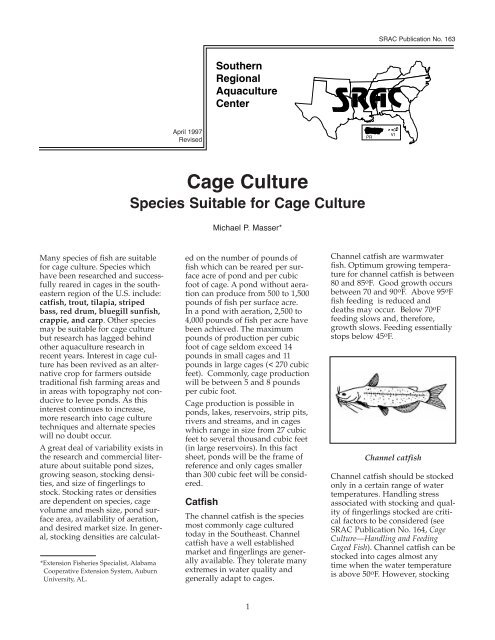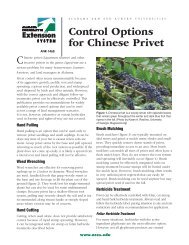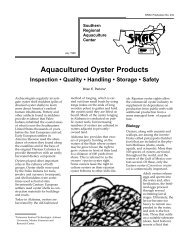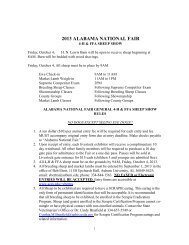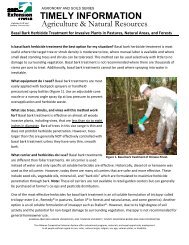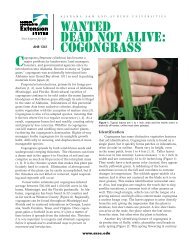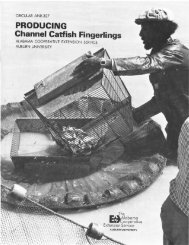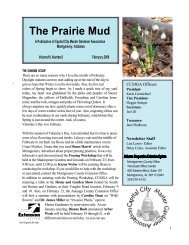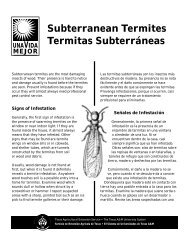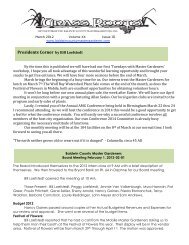Cage Culture: Species Suitable for Cage Culture - SRAC Fact Sheets
Cage Culture: Species Suitable for Cage Culture - SRAC Fact Sheets
Cage Culture: Species Suitable for Cage Culture - SRAC Fact Sheets
You also want an ePaper? Increase the reach of your titles
YUMPU automatically turns print PDFs into web optimized ePapers that Google loves.
Many species of fish are suitable<br />
<strong>for</strong> cage culture. <strong>Species</strong> which<br />
have been researched and successfully<br />
reared in cages in the southeastern<br />
region of the U.S. include:<br />
catfish, trout, tilapia, striped<br />
bass, red drum, bluegill sunfish,<br />
crappie, and carp. Other species<br />
may be suitable <strong>for</strong> cage culture<br />
but research has lagged behind<br />
other aquaculture research in<br />
recent years. Interest in cage culture<br />
has been revived as an alternative<br />
crop <strong>for</strong> farmers outside<br />
traditional fish farming areas and<br />
in areas with topography not conducive<br />
to levee ponds. As this<br />
interest continues to increase,<br />
more research into cage culture<br />
techniques and alternate species<br />
will no doubt occur.<br />
A great deal of variability exists in<br />
the research and commercial literature<br />
about suitable pond sizes,<br />
growing season, stocking densities,<br />
and size of fingerlings to<br />
stock. Stocking rates or densities<br />
are dependent on species, cage<br />
volume and mesh size, pond surface<br />
area, availability of aeration,<br />
and desired market size. In general,<br />
stocking densities are calculat-<br />
*Extension Fisheries Specialist, Alabama<br />
Cooperative Extension System, Auburn<br />
University, AL.<br />
April 1997<br />
Revised<br />
<strong>Cage</strong> <strong>Culture</strong><br />
<strong>Species</strong> <strong>Suitable</strong> <strong>for</strong> <strong>Cage</strong> <strong>Culture</strong><br />
ed on the number of pounds of<br />
fish which can be reared per surface<br />
acre of pond and per cubic<br />
foot of cage. A pond without aeration<br />
can produce from 500 to 1,500<br />
pounds of fish per surface acre.<br />
In a pond with aeration, 2,500 to<br />
4,000 pounds of fish per acre have<br />
been achieved. The maximum<br />
pounds of production per cubic<br />
foot of cage seldom exceed 14<br />
pounds in small cages and 11<br />
pounds in large cages (< 270 cubic<br />
feet). Commonly, cage production<br />
will be between 5 and 8 pounds<br />
per cubic foot.<br />
<strong>Cage</strong> production is possible in<br />
ponds, lakes, reservoirs, strip pits,<br />
rivers and streams, and in cages<br />
which range in size from 27 cubic<br />
feet to several thousand cubic feet<br />
(in large reservoirs). In this fact<br />
sheet, ponds will be the frame of<br />
reference and only cages smaller<br />
than 300 cubic feet will be considered.<br />
Catfish<br />
Michael P. Masser*<br />
The channel catfish is the species<br />
most commonly cage cultured<br />
today in the Southeast. Channel<br />
catfish have a well established<br />
market and fingerlings are generally<br />
available. They tolerate many<br />
extremes in water quality and<br />
generally adapt to cages.<br />
1<br />
PR<br />
<strong>SRAC</strong> Publication No. 163<br />
VI<br />
Channel catfish are warmwater<br />
fish. Optimum growing temperature<br />
<strong>for</strong> channel catfish is between<br />
80 and 85 o F. Good growth occurs<br />
between 70 and 90 o F. Above 95 o F<br />
fish feeding is reduced and<br />
deaths may occur. Below 70 o F<br />
feeding slows and, there<strong>for</strong>e,<br />
growth slows. Feeding essentially<br />
stops below 45 o F.<br />
Channel catfish<br />
Channel catfish should be stocked<br />
only in a certain range of water<br />
temperatures. Handling stress<br />
associated with stocking and quality<br />
of fingerlings stocked are critical<br />
factors to be considered (see<br />
<strong>SRAC</strong> Publication No. 164, <strong>Cage</strong><br />
<strong>Culture</strong>—Handling and Feeding<br />
<strong>Cage</strong>d Fish). Channel catfish can be<br />
stocked into cages almost any<br />
time when the water temperature<br />
is above 50 o F. However, stocking
at temperatures above 80oF may<br />
adversely stress the fish and lead<br />
to disease and possibly death.<br />
Stocking poor quality fingerlings<br />
be<strong>for</strong>e the water reaches 60oF (when predictable feeding occurs)<br />
can lead to handling stress compounded<br />
by nutritional stress<br />
from the lack of food intake. For<br />
these reasons it is probably best to<br />
stock when water temperatures<br />
are between 60 and 70oF. Of<br />
course, fish farmers may have to<br />
learn how to handle and stock<br />
fingerlings at any range of temperatures<br />
to be competitive and<br />
meet their marketing objectives.<br />
Size of catfish fingerlings to be<br />
stocked depends on the length of<br />
growing season, availability, and<br />
marketing strategy. The minimum<br />
size fingerling which can be<br />
stocked into a cage made of 1 /2inch<br />
mesh is approximately 5<br />
inches. Generally 6- to 8-inch fingerlings<br />
are stocked into cages. If<br />
a 1 1 /4- to 1 1 /2-pound fish is the<br />
desired market size at harvest it<br />
may be necessary to stock a larger<br />
fingerling or stock at a lower<br />
stocking rate. A larger fingerling<br />
must be stocked in the northern<br />
part of the southeastern region (or<br />
at high elevations) where the<br />
growing season is shorter. It is not<br />
uncommon to stock 8- to 10-inch<br />
fingerlings where the growing<br />
season is 180 days or less.<br />
Availability and cost of larger fingerlings<br />
may make stocking these<br />
sizes prohibitive. A fingerling<br />
over 10 inches in length may not<br />
adapt well to a cage.<br />
Uni<strong>for</strong>mity of fingerling size is<br />
also important. Research has<br />
shown that catfish fingerlings of<br />
uni<strong>for</strong>m size (all within 1 /2 inch<br />
of the same length) will grow<br />
more homogeneously, reaching a<br />
larger average size and increasing<br />
total cage production over fingerlings<br />
with a 1 inch or longer variation<br />
in length.<br />
The strain or variety of channel<br />
catfish stocked into cages can<br />
make a great difference in production<br />
or yield. Different strains<br />
have been developed or selected<br />
at both public and private hatch-<br />
eries throughout the Southeast.<br />
Not all of these strains do equally<br />
well in cages even though they<br />
may grow well in open ponds. In<br />
fact, strain research in cages suggest<br />
that some strains can grow as<br />
much as 50 percent faster than<br />
other strains. There<strong>for</strong>e, probably<br />
the best general advice is to talk to<br />
other cage producers in your area<br />
and ask which fingerling source<br />
they like and have been successful<br />
with. Research done at Auburn<br />
University has shown that strains<br />
with a Kansas or Marion (named<br />
after the Federal hatcheries)<br />
ancestry do well in cage conditions.<br />
This same research has<br />
shown that many private hatcheries,<br />
but certainly not all, have<br />
channel catfish strains that grow<br />
well in cages. Ask other cage producers<br />
and use a strain that has a<br />
good reputation.<br />
Stocking densities <strong>for</strong> catfish fingerlings<br />
in cages range from 5 to<br />
14 per cubic foot of cage. This<br />
equates to 250 to 600 fish in a 4 x 4<br />
feet cylindrical cage. Generally<br />
speaking it is best to stock at the<br />
low densities (5 to 8 per cubic<br />
foot) when first attempting cage<br />
culture, particularly if supplemental<br />
aeration is not present. Do not<br />
stock below a density of 5 per<br />
cubic foot or catfish may fight,<br />
leading to injury and disease.<br />
Some recommended stocking<br />
rates <strong>for</strong> small cages are given in<br />
Table 1. Even with supplemental<br />
aeration available it may be<br />
advantageous, <strong>for</strong> stress reasons,<br />
to stock additional cages rather<br />
than overstock individual cages.<br />
Overstocking can reduce growth<br />
and increase disease problems.<br />
Table 1. Recommended stocking<br />
rates <strong>for</strong> cages.<br />
Stocking<br />
<strong>Cage</strong> Size Rates<br />
4 x 4 feet (round) 250 - 400<br />
4 x 4 x 4 feet 320 - 500<br />
8 x 4 x 4 feet 640 - 1,000<br />
8 x 8 x 4 feet 1,280 - 2,000<br />
6 x 12 x 4 feet 1,500 - 2,300<br />
2<br />
Blue catfish, hybrid catfish (blue<br />
catfish male x channel catfish<br />
female), and bullhead catfish have<br />
been stocked in cages with limited<br />
success. Blue and hybrid catfish<br />
do not grow as well in cages as<br />
channel catfish. Bullhead catfish<br />
have been raised in cages and<br />
appear to do relatively well.<br />
Recommended stocking size is a<br />
6-inch fingerling. Bullheads do<br />
not grow as large as channel catfish,<br />
however, and are expected to<br />
get to only 1 /2 pound in a growing<br />
season. Bullhead fingerlings<br />
are generally difficult to find and<br />
may be expensive.<br />
Trout<br />
Rainbow, brown, and brook trout<br />
can all be reared in cages.<br />
Rainbow trout are most often cultured<br />
because of the availability of<br />
fingerlings, established market,<br />
and adaptability to cages. Basic<br />
culture of all three species is similar.<br />
Rainbow trout will be<br />
described here, but the in<strong>for</strong>mation<br />
should apply to other trout<br />
species.<br />
Rainbow trout<br />
Trout are coldwater species.<br />
Optimum growth temperature <strong>for</strong><br />
trout is between 55 and 65 o F, but<br />
good growth is attained between<br />
50 and 68 o F. At 70 o F severe heat<br />
stress begins, usually followed by<br />
death if exposure is prolonged.<br />
Below 45 o F feed conversion drops<br />
significantly and, there<strong>for</strong>e,<br />
growth. These temperature<br />
regimes make cage culture of<br />
trout a wintertime only activity in<br />
most of the southeastern United<br />
States, except where cold spring<br />
water or high altitude lowers<br />
summertime water temperatures.
It is necessary to stock a 6- to 8inch<br />
fingerling trout in most of the<br />
Southeast to obtain 1 /2- to 1pound<br />
trout by the end of the<br />
growing season. Stocking should<br />
begin in the fall as soon as the<br />
water temperature drops below<br />
65oF. Failure to harvest be<strong>for</strong>e<br />
water temperatures reach 70oF in<br />
the spring will mean loss of your<br />
product and profit.<br />
Stocking densities <strong>for</strong> trout in<br />
cages may be a little higher than<br />
those <strong>for</strong> catfish. The higher oxygen<br />
levels maintained by cooler<br />
water and smaller sizes at harvest<br />
allow trout to be stocked at the<br />
higher densities (Table 1) without<br />
much concern <strong>for</strong> low dissolved<br />
oxygen problems. In fact densities<br />
as high as 15 trout per cubic foot<br />
may be acceptable.<br />
Tilapia<br />
Several species of tilapia and their<br />
hybrids have been reared in cages.<br />
<strong>Species</strong> most often cultured are T.<br />
nilotica, Florida red tilapia,<br />
Taiwanese red tilapia, Aurea red<br />
tilapia, and T. aurea. Some tilapia<br />
species or hybrids are illegal or<br />
restricted in many states. Check<br />
with your state Department of<br />
Natural Resources, Fish and<br />
Wildlife, or an Extension fisheries<br />
(or aquaculture) specialist be<strong>for</strong>e<br />
culturing these species.<br />
Tilapia<br />
Tilapia are truly a tropical fish<br />
with origins in central Africa.<br />
They tolerate high temperatures<br />
well, can feed on plankton and<br />
detritus, are resistant to water<br />
quality deterioration, reproduce<br />
readily, and have excellent flesh<br />
quality. For these reasons they<br />
have been stocked all over the<br />
tropical world and probably rank<br />
as the most widely cultured tropical<br />
freshwater fish. In temperate<br />
climates, however, they cannot<br />
survive winter water temperatures.<br />
Optimum temperatures <strong>for</strong><br />
tilapia are from 80 to 90oF, but<br />
good growth is maintained<br />
between 75 and 95oF. Death<br />
occurs at approximately 50 to 55oF depending on the species, and<br />
diseases become common below<br />
60oF. Tilapia should not be<br />
stocked until the water temperature<br />
reaches 70oF. Fingerlings should be stocked at 4<br />
to 5 inches long (or larger) and<br />
can be stocked at the densities<br />
described in Table 1. One distinct<br />
advantage in the cage culture of<br />
tilapia is that they are unable to<br />
reproduce in cages and, there<strong>for</strong>e,<br />
do not overpopulate the pond.<br />
Better growth is achieved if allmale<br />
populations are stocked. At<br />
the lower stocking densities<br />
tilapia will have excellent feed<br />
conversion because they filter feed<br />
on plankton passing through the<br />
cage. Tilapia should be harvested<br />
be<strong>for</strong>e water temperature reaches<br />
60oF. Tilapia can be stocked in the same<br />
cage with channel catfish (called<br />
polyculture). Research has shown<br />
that tilapia polycultured with catfish<br />
will increase catfish growth<br />
because they stimulate the catfish<br />
to feed more aggressively, increasing<br />
feed consumption. In polyculture<br />
with catfish, tilapia should be<br />
stocked at rates between 1 and 3<br />
tilapia per 10 catfish.<br />
Striped bass<br />
Striped bass and their hybrids<br />
have been successfully reared in<br />
cages. Striped bass are illegal or<br />
restricted in many states. Check<br />
with your state Department of<br />
Natural Resources, Fish and<br />
Wildlife, or an Extension fisheries<br />
(or aquaculture) specialist be<strong>for</strong>e<br />
culturing these species.<br />
3<br />
Striped bass temperature tolerances<br />
and preferences are similar<br />
to those <strong>for</strong> channel catfish<br />
(described previously). One<br />
observed problem with striped<br />
bass is their poor growth and survival<br />
in soft water. Because of this,<br />
it is recommended that striped<br />
bass and their hybrids should be<br />
stocked in waters with total alkalinity<br />
of at least 50 ppm. Stocking<br />
densities recommended are the<br />
same as given in Table 1.<br />
Striped bass<br />
At present the greatest problem in<br />
cage culture of striped bass is the<br />
availability of large or advanced<br />
fingerlings. Most fingerlings are<br />
sold at sizes too small to be<br />
stocked into cages. A minimum<br />
4-inch fingerling is needed <strong>for</strong><br />
stocking and 8-inch fingerlings<br />
would be preferable. Fingerlings<br />
should be graded closely as cannibalism<br />
is a problem in young<br />
striped bass.<br />
Red drum<br />
The culture of red drum (redfish)<br />
is a recent phenomenon. The<br />
research in cage culture of red<br />
drum is very limited. At present<br />
temperature tolerances and preferences<br />
of red drum appear to be<br />
about the same as those <strong>for</strong> channel<br />
catfish (described previously),<br />
except that red drum do not<br />
appear to tolerate rapid temperature<br />
drops and require water of<br />
high alkalinity and total hardness.<br />
For this reason, harvest is recommended<br />
be<strong>for</strong>e the temperature<br />
drops sharply in the late fall. Do<br />
not overwinter these fish in cages.<br />
At present the greatest problem<br />
with red drum, like hybrid striped<br />
bass, is the availability of large
fingerlings <strong>for</strong> stocking. The recommended<br />
stocking size is a 6- to<br />
8-inch fingerling. Cannibalism is<br />
also a problem in red drum, so<br />
fingerlings need to be graded<br />
closely.<br />
Bluegill<br />
Bluegill sunfish and their hybrids<br />
have been reared in cages with<br />
some success. Temperature tolerances<br />
and preferences of bluegill<br />
are similar or slightly lower than<br />
those <strong>for</strong> channel catfish<br />
(described previously). Bluegill<br />
are aggressive and will take food<br />
at lower temperatures than catfish<br />
and should be stocked be<strong>for</strong>e the<br />
water temperatures reach 60 o F.<br />
Limited research on bluegill culture<br />
in cages has shown poor feed<br />
conversions.<br />
Bluegill<br />
Fingerling bluegill/hybrids<br />
should be 3 to 4 inches or larger at<br />
stocking and should be graded<br />
carefully to assure uni<strong>for</strong>mity.<br />
Stocking densities <strong>for</strong> bluegill<br />
should be in the upper range of<br />
those given in Table 1.<br />
Crappie<br />
Limited research has been conducted<br />
on the cage culture of<br />
crappie (black, white and hybrids)<br />
in the Midwest. These crappie<br />
were captured from the wild then<br />
transported and stocked into<br />
cages. Results of these preliminary<br />
studies indicate that black crappie<br />
adapted best to cage conditions<br />
but overall survival and growth<br />
were poor. The fish were fed a<br />
high protein (43 percent) semisoft<br />
diet. More research needs to<br />
be conducted on the culture of<br />
crappies in cages.<br />
Carp<br />
Crappie<br />
Common carp (including German,<br />
Israeli, mirror, and other varieties)<br />
have been successfully cultured in<br />
cages and are commercially produced<br />
in cages in much of<br />
Europe, Asia and the Middle East.<br />
Total production of common carp<br />
in cages is usually higher than<br />
that of most other species. It is not<br />
uncommon to produce up to 400<br />
pounds of common carp per cubic<br />
yard of cage.<br />
Chinese carp (grass, silver, bighead,<br />
and silver x bighead<br />
hybrids) also have been reared in<br />
cages. These Chinese carp are illegal<br />
or restricted in many states.<br />
Check with your state Department<br />
of Natural Resources, Fish and<br />
Wildlife, or an Extension fisheries<br />
(or aquaculture) specialist be<strong>for</strong>e<br />
culturing these species.<br />
Common, grass, silver, and bighead<br />
carp (and silver x bighead<br />
hybrids) have approximately the<br />
same temperature preferences and<br />
tolerances as channel catfish<br />
(described previously). Fingerlings<br />
should be stocked into cages<br />
at a minimum of 4 to 5 inches in<br />
length at the same stocking densities<br />
listed in Table 1. Common and<br />
grass carp are usually fed a 32 to<br />
36 percent protein complete floating<br />
pellet. Silver and bighead carp<br />
(and their hybrid) are filter feed-<br />
4<br />
ers and can be placed in cages in<br />
nutrient rich ponds (eutrophic)<br />
without any supplemental feeding.<br />
The reason <strong>for</strong> stocking grass<br />
carp in cages is to produce a larger<br />
fingerling <strong>for</strong> stocking into<br />
recreational ponds (<strong>for</strong> weed control)<br />
with large predatory fish.<br />
Carp<br />
One research study has been done<br />
using silver x bighead carp<br />
hybrids cultured in cages. The<br />
hybrids were stocked at densities<br />
of approximately two per cubic<br />
foot or 120 in 8 x 4 x 4 rectangular<br />
cages. The cages were not fed and<br />
no artificial water circulation provided.<br />
These fish fed on plankton<br />
and grew quickly from 10 inches<br />
to average 3.7 pounds in one<br />
growing season.<br />
Choose species carefully<br />
Picking the fish species that will<br />
do well in cages in your particular<br />
location is important. For example,<br />
it is difficult to get enough<br />
growth on trout during the short<br />
winters in Gulf coastal plain locations<br />
but not in the longer winters<br />
in states like Kentucky. Probably<br />
the most important decision in<br />
determining which species you<br />
should culture in cages is: Is there<br />
a market <strong>for</strong> them? Furthermore,<br />
is that market local or must they<br />
be transported <strong>for</strong> long distances?<br />
Is it a live market or a processed<br />
market? What size is preferred in<br />
the market? All potential producers<br />
should evaluate markets<br />
be<strong>for</strong>e selecting the species to be<br />
cultured.<br />
The work reported in this publication was supported in part by the Southern Regional Aquaculture Center through Grant No. 94-38500-0045 from<br />
the United States Department of Agriculture, Cooperative States Research, Education, and Extension Service.


